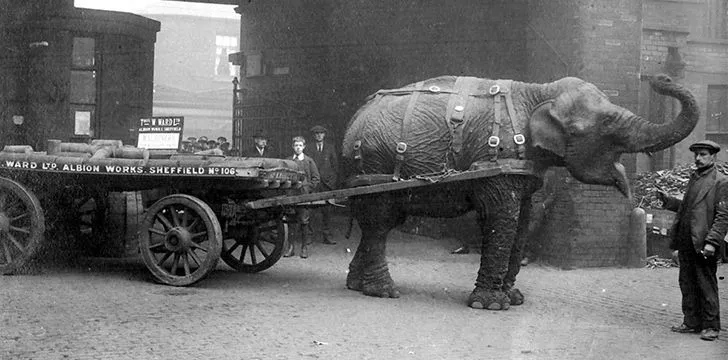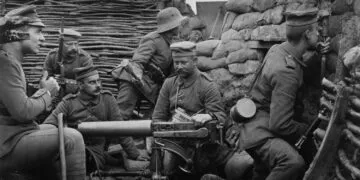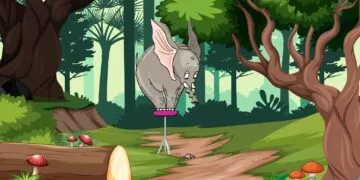Britain’s Northern City of Sheffield is known across the United Kingdom as “The Steel City.”
Sheffield’s high number of steelworks earned it this nickname, and as such it was a vital city to the British war effort in both the First and Second World Wars.
During the First World War, the sheer number of steel produced in Sheffield was crucial to the military-industrial machine. As such, scrap metal collecting was commonplace in Sheffield.
One wartime icon of Sheffield would come from the steel industry, and she was Lizzie the Indian Elephant.
“Pressed into Service”

In 1916, local Sheffield scrap dealer Thomas Ward’s business was vital to feeding Sheffield’s foundries and steel makers, providing a thousand tons of scrap metal to the city’s steel industry every day.
As the government had requisitioned most of the country’s horses for use in Europe by this time, Ward needed something to pull his cart around the city.
Due to this need, Ward leased Lizzie from a menagerie run by William Sedgwick in Sheffield’s Wicker Arches.
Lizzie helped transport machinery and munitions around the city as well as keeping Sheffield’s foundries running with her daily deliveries of scrap metal.
A Rate Sheffield Lass

Lizzie became a commonplace feature around Sheffield, often seen plodding along the city’s streets, up and down Sheffield’s many hills, and venturing to the steelworks to keep their furnaces roaring.
She wore a pair of specially made leather boots to stop the sharp scrap metal from hurting her feet when she was in the steelworks.
At the end of each day, Lizzie could be seen going to sleep in her stable.
She very quickly captured the hearts of Sheffield’s locals. Every day they would see her hard at work and, being hard-working people themselves, came to view her as one of their own.
Also, like the Northern locals of Sheffield, Lizzie was renowned for being a little cheeky at times.
She once ate a young schoolboy’s cap, and she also popped her trunk through an open window to grab a freshly-baked pie that was cooling down.
Lizzie also once knocked over a traction engine whilst playing with it like a toy. However, she also helped out beyond her day job when she pulled out a snowed-in engine on her own.
It didn’t take long before Lizzie had become a local celebrity in Sheffield.
After the War
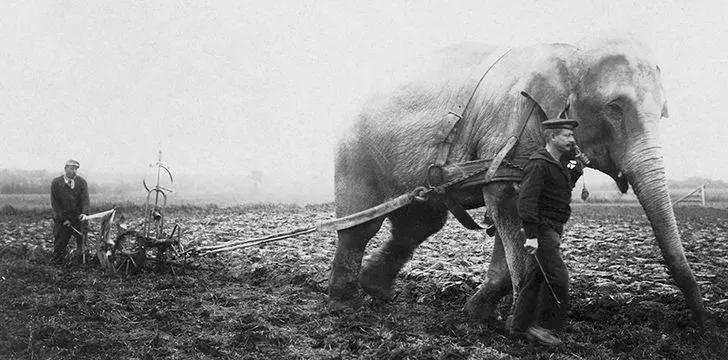
After the end of the Great War, there are several conflicting stories of what happened to Lizzie.
Some stories say that Lizzie continued working for Thomas Ward after the war – after all she could do the work of three horses alone.
These stories state that Lizzie eventually retired from her work for Ward after the city’s cobbled streets hurt her feet, living out her days as a plough-puller on a farm.
Other stories suggest she returned to Sedgwick’s menagerie and entered work with a circus, possibly even the legendary Bostock and Wombwell circus tours, or that she was purchased by a zoo.
The “Herd of Sheffield”
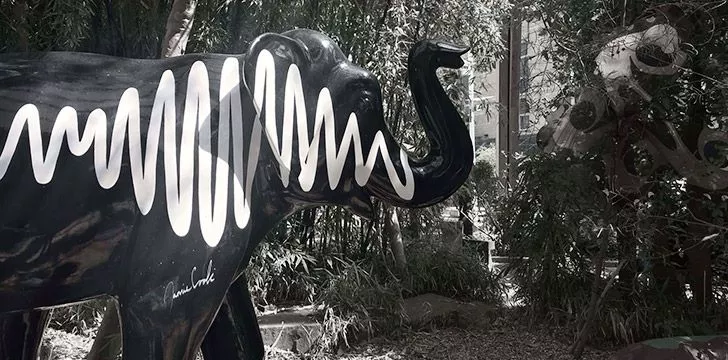
Although it’s not known what happened to Lizzie, the effect she had on Sheffield was never forgotten.
Sheffield’s steel industry proved crucial to the munitions industry for Britain, and without her, their efforts would have been severely diminished.
She also served as a symbol for how welcoming Sheffield was.
After the First World War, Sheffield saw high numbers of immigration and is one of the only cities to not experience social upheaval or unrest as a result of the post-war immigration after the First World War.
In 2016, Sheffield put on its biggest public art exhibition in honor of Lizzie. 58 different 1.6-meter fiberglass elephants were dotted around Sheffield’s city center.
Decorated in vibrant patterns by local artists, these elephants sat on exhibition across the city for the duration of the summer before being auctioned off to support Sheffield Children’s Hospital in October 2016.
Even almost a century after her service, Lizzie’s memory, and legacy continues to impact the city of Sheffield in a beautifully positive way.
